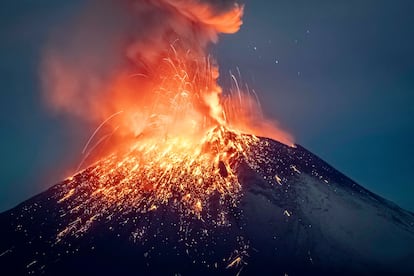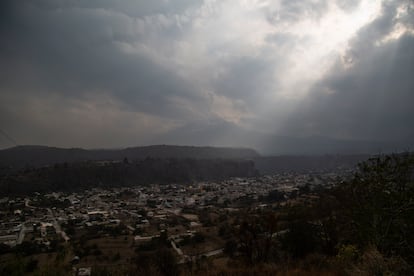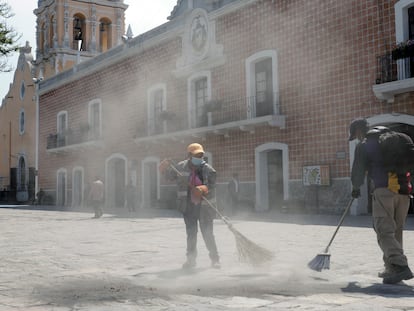Scientists predict months of ash from Popocatépetl but say major eruption is unlikely
After hundreds of explosions and more than 40 hours of continuous emissions, researchers believe the Mexican volcano will stabilize but with high levels of activity


There is a giant roaring under the earth of central Mexico. The Popocatépetl volcano has been active since 1994 but over the past few days alarm bells have been ringing due to its increasing activity: hundreds of explosions across more than 40 uninterrupted hours. Around 7,000 military personnel have been mobilized in the states of Puebla, Morelos, and the State of Mexico in case it is necessary to evacuate the populations living near the volcano. School classes have been suspended in 40 municipalities and a security perimeter of 12 kilometers (7.5 miles) around the volcano has been established. Scientists, however, have called for calm: this episode is not unique, experts have stated, similar events have taken place many times before and recent history suggests the volcano will stabilize — without a dramatic eruption — at a high level of activity and ash emission. “It is likely that in the coming months there will be many episodes like the one we are seeing now,” notes volcanologist Robin Campion. “It is a continuous gas leak that generates a lot of noise and carries with it incandescent fragments and ash,” he tells EL PAÍS.
Campion has spent three days in the Paso de Cortés, the gap between the Iztaccíhuatl and Popocatépetl volcanoes, monitoring the situation. His eyes are sore, his nose a little red. The ash emission is not innocuous. On Tuesday night he will set out again, aiming to get four kilometers closer to the volcano, inside the restricted area. “What stands out most is the duration of the episode, 40 hours non-stop. It is an anomalous episode because of its length and the constant production of ash for so long,” he says.
This ash is now falling over the state of Puebla and has forced the closure of the Hermanos Serdán airport, but the next winds are headed in the direction of Mexico City, where on Saturday chaos broke out at the already saturated Benito Juárez International Airport due to the closure of runways for a few hours. “The probability of ash reaching Mexico City is very high. We know that during the winter the ashes go towards Puebla, but from May onwards, in June and July, it will go toward Mexico City,” researcher Ana Lillian Martín said during a conference organized by the National Autonomous University of Mexico (UNAM).
The volcanology expert explains that the ashes irritate the respiratory tract and eyes, and can also cause itchy skin. When they come into contact with water, they create a muddy paste that is very difficult to get rid of. They also make visibility poor and can get into airplane engines and damage car windshields, as well as affecting cell phone telecommunications. As such, the National Center for Prevention of Disasters (CENAPRED) has recommended people remain indoors, cover doors and windows, wear a mask and goggles if they need to go outside and avoid driving.
How long the situation will last remains unclear. “We do not have a crystal ball to answer that,” says Campion, who points out that it is difficult to make accurate forecasts in the three timeframes that are in play: it is unknown how long the volcanic episode will last - it could be days - or when the most intense period that is currently underway will end - it could be months - or when a volcano that has been active for three decades could become dormant again, something that may not occur for years. “There are many things that we have no way of forecasting with respect to the volcano,” Campion explains. “Quantifying is important, because it allows us to compare the current activity with previous episodes: it is like measuring a river and its floods.”

“What we are witnessing in geological and volcanic terms is something small”
Times when talking about volcanoes do not correspond to any human equivalent. It helps to imagine them as large machines that accumulate energy and then release it. For example, explains researcher Servando de la Cruz, Popocatépetl violently erupted 23,000 years ago, and again 14,000 years ago. Another huge eruption took place in the year 800 A.D. “These very violent episodes occur very far apart in time. The other type of activity is one of smaller cycles, easier to manage by the volcano, as was the case from 1919 to 1927, or from 1994 until now,” says the UNAM expert.
The Institute of Geophysics considers that the volcano is reactivated every 70 years, remains active for a while then goes back to sleep. For almost three decades, it has had one eye open. In this most recent period of activity there have been many episodes like the one now taking place: in December 1994 and in 2000, a well as in 2012, 2019, and 2020.
The energy peaks being registered have not yet surpassed, for example, those at the turn of the century. “During the period of activity in 2000, 42,000 people were evacuated and 14,000 were forced to go to shelters. We are not in that situation or in that condition,” says researcher Carlos Valdés. Carlos Gutiérrez Martínez, research director of CENAPRED, agrees with this assessment: “The volcano is at least half a million years old. Without wanting to minimize the problem, what we are witnessing in geological and volcanic terms is something small.”
The current picture began to take shape at the end of December, explains Campion. The volcano began to recharge with juvenile magma, which is richer in gases, and gases are the engine of eruptions. The increase was gradual at first. On May 10 at 00:05 a.m., a rumbling sound rattled the windows of the nearest towns, waking residents from their sleep. More explosions were recorded, until, finally, on May 19, the parameters that measure gases, tremor, ash production, and thermal energy production made an accelerated leap. “Everything increased in parallel,” says Campion.
Since then, it has not stopped. This continuity has led to the lifting of the phase 3 yellow alert. To reach a red alert, the situation would have to get out of control, which does not seem likely at this juncture. “We are prepared to [issue a red alert] if necessary, but everything indicates that the greatest likelihood is the activity will remain more in line with what we have seen in the last 27 years. On previous occasions the same thing has happened and in no instance have we needed to go to higher level of alert,” says De la Cruz.
The current situation at Popocatépetl can be likened to a hospital with a patient in intensive care: there are doctors on the ward 24 hours a day and specialists in different fields observing, analyzing, and making decisions so that everything goes according to plan. Attention is now focused on whether, and how, its energy output decreases. An abrupt drop could mean that there is a plugging of the volcano’s conduit, which would trigger what scientists call an explosive release.
For the time being, experts say it is positive that it is continuing at a “steady stream.” “It means that the conduit system is still open and still releasing energy,” Campion explains. “Over the next few months, it’s all going to depend on the amount of new magma that is entering the system and the ability of the conduit to evacuate the excess pressure that this magma generates. Hopefully it will continue to be fairly constant and moderate and not all of it will be
There are over 2,000 volcanoes in Mexico, of which 48 are active or potentially active. Almost two-thirds of the country’s population lives on the ground shaped by volcanic activity. Nine million people live in a radius of just 20 kilometers (12 miles) around Popocatépetl and in a 60 km (37 mile) radius that figures rises to 25 million. Being so close to a densely populated area has made Popocatépetl the second-riskiest volcano in the world. Despite spectacular images of the erupting volcano, the rain of ash, and the closure of airports in Mexico City and creating a perfect apocalyptic framework, Campion insists: “We must resist the temptation of catastrophism.”
Sign up for our weekly newsletter to get more English-language news coverage from EL PAÍS USA Edition









































